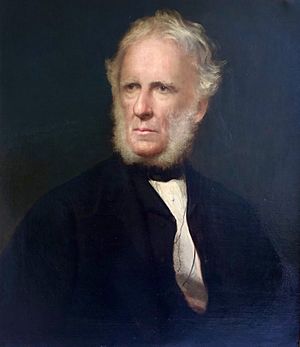Edmund Potter facts for kids
Edmund Potter (1802–1883) was an important businessman from Manchester, England. He was also a Member of Parliament, which means he helped make laws for the country. You might know his granddaughter, Beatrix Potter, who wrote and illustrated famous children's books like Peter Rabbit.
Edmund Potter was a Unitarian, a type of Christian faith. From 1861 to 1874, he was a Liberal MP for the area of Carlisle.
In 1825, Potter moved his business to Glossop. He rebuilt an old factory called Boggart Mill and turned it into a printworks. His family moved to Dinting Lodge in 1842. At first, printing on fabric called calico was done by hand. But Potter brought in special machines to do it much more accurately. By 1883, his factory had 350 workers and 42 machines. It had printed 1 million pieces of fabric. This made it the biggest calico printing factory in the world!
Contents
Edmund Potter's Family History
Early Family Life
Edmund Potter came from a family of merchants. His great-grandfather, James Potter (1710–1770), was a flax merchant from Hindley. He later moved his business to New Market Place in Manchester.
James's son, John Potter, lived in a more rural area of Manchester called Ardwick Green. John married Catherine Eccles from Macclesfield. They had three sons and two daughters. John, their first son, became a calico printer. James (2), their third son, was Edmund Potter's father.
Edmund's Immediate Family
Edmund Potter lived with his wife, Jessica Crompton, in Greenheys, Manchester. In 1842, they moved to Dinting Lodge in Glossop. Edmund started the Dinting Vale Printworks. He first ran it with his cousin, Charles Potter. Later, their business partnership ended, and Charles started printing wallpaper in Darwen.
Edmund and Jessica had seven children. Two of their sons are especially notable. Edmund (2) took over his father's printing business in 1862. His other son, Rupert, became a lawyer. Rupert's daughter was the famous children's author and illustrator, Beatrix Potter.
Innovations in Calico Printing
What is Calico Printing?
Calico is a type of plain cotton fabric. For a long time, patterns were printed onto calico using wooden blocks. This was a slow process. Also, there were often problems with workers and high taxes on the printed fabric.
Potter's Machine Printing
Edmund Potter changed how calico was printed. He brought in machines to do the work instead of relying on hand printing. This made the process much faster and more precise. His factory became the largest calico printer in the world.
Later, in 1899, his company joined with other rival printing companies. They formed a large group called the Calico Printers' Association. By 1948, this association was printing enough calico to stretch for 15,000 miles (24,000 km)!
Helping the Community
Belief in Education
Edmund Potter strongly believed that everyone should have the chance to learn. He wanted his workers to be educated.
Reading Room and School
In 1885, he built a special reading room and library in his factory yard. It was filled with books and newspapers for his workers to use. He also bought a nearby factory called Dinting Mill. He used the top floor of this mill as a day school. Both boys and girls could attend, including some of his young part-time workers. The bottom floor of the mill was used to get black dye from a type of wood called logwood. Because of this, the mill became known as Logwood Mill.


